Energetic and Exergetic Analysis of a Transcritical N2O Refrigeration Cycle with an Expander
Abstract
:1. Introduction
2. System Description
3. Thermodynamic Modeling
3.1. Energy Analysis
3.2. Exergy Analysis
3.3. Parameter Determination
- (1)
- The compressor has an isentropic efficiency of 75%;
- (2)
- The expander has an isentropic efficiency of 65%;
- (3)
- The mechanical transmission efficiency between the compressor and the expander is 85%;
- (4)
- The outlet temperature of the gas cooler is 30 °C ≤ tgc ≤ 55 °C;
- (5)
- The evaporating temperature is −40 °C ≤ teva ≤ 10 °C.
4. Results and Discussion
4.1. Energy Analysis of the Throttling Valve Cycle and Expander Cycle Using N2O
4.2. Energy Analysis of the Expander Cycle Using N2O and CO2 as Refrigerants
4.3. Exergy Analysis of the Throttling Valve Cycle and Expander Cycle Using N2O
4.4. Exergy Analysis of the Expander Cycle Using N2O and CO2 as Refrigerants
5. Conclusions
- (1)
- For the two cycles of the investigation, the optimum COP increases and the optimum discharge pressure decreases with an increase in the evaporating temperature and a decrease in the gas cooler exit temperature for both working fluids.
- (2)
- Effects of the evaporating and gas cooler exit temperatures on the cooling COP and the corresponding optimum discharge pressures are similar for the N2O and CO2 expander cycles. The N2O expander cycle exhibits a larger COP than the CO2 expander cycle. In addition, the N2O system is safer than the CO2 system owing to a lower discharge pressure.
- (3)
- At the given conditions, the N2O expander cycle has a lower optimum discharge pressure and a higher maximum cooling COP compared to the N2O throttling valve cycle.
- (4)
- In the N2O throttling valve cycle, the irreversibility of the throttling valve is a maximum, and the exergy losses of the gas cooler and compressor are ordered second and third, respectively. In the N2O expander cycle, the largest exergy loss occurs in the gas cooler, followed by the compressor and the expander.
- (5)
- Compared with the CO2 expander cycle and N2O throttling valve cycle, the N2O expander cycle has the smallest component specific exergy loss and the highest exergy efficiency. In addition, the maximum COP and the optimum exergy efficiency cannot be obtained simultaneously.
Acknowledgments
Author Contributions
Conflicts of Interest
Abbreviation
| Nomenclature | |
| COP | coefficient of performance (-) |
| TVC | throttling valve cycle (-) |
| ODP | ozone depletion potential (-) |
| GWP | global warming potential (-) |
| EC | expander cycle (-) |
| h | specific enthalpy (kJ kg−1) |
| s | specific entropy (kJ kg−1 K−1) |
| w | specific work (kJ kg−1) |
| I | specific irreversibility (kJ kg−1) |
| P | pressure (bar) |
| T,t | temperature (K, °C) |
| q | specific heat transfer rate (kJ kg−1) |
| Greek Symbols | |
| η | efficiency (%) |
| ε | exergy efficiency (%) |
| Subscripts | |
| 0 | reference environment |
| exp | expander |
| tv | throttling valve |
| is | isentropic process |
| com | compressor |
| eva | evaporator |
| gc | gas cooler |
| tot | total |
| r | refrigerated object |
| elec | electric |
| mt | mechanical transmission |
References
- Protocol, M. Montreal Protocol on Substances that Deplete the Ozone Layer; US Government Printing Office: Washington DC, USA, 1987.
- Calm, J.M. The next generation of refrigerants—Historical review, considerations, and outlook. Int. J. Refrig. 2008, 31, 1123–1133. [Google Scholar] [CrossRef]
- Kruse, H.; Rüssmann, H. The natural fluid nitrous oxide—An option as substitute for low temperature synthetic refrigerants. Int. J. Refrig. 2006, 29, 799–806. [Google Scholar] [CrossRef]
- United Nations Environment Programme (UNEP). 2014 Report of the Refrigeration, A/C and Heat Pumps Assessment Report. Available online: http://ozone.unep.org/sites/ozone/files/documents/RTOC-Assessment-Report-2014.pdf (accessed on 4 January 2018).
- Lorentzen, G.; Pettersen, J. A new, efficient and environmentally benign system for car air-conditioning. Int. J. Refrig. 1993, 16, 4–12. [Google Scholar] [CrossRef]
- Liu, F.; Groll, E.A.; Ren, J. Comprehensive experimental performance analyses of an ejector expansion transcritical CO2 system. Appl. Therm. Eng. 2016, 98, 1061–1069. [Google Scholar] [CrossRef]
- Deng, J.Q.; Jiang, P.X.; Lu, T.; Lu, W. Particular characteristics of transcritical CO2 refrigeration cycle with an ejector. Appl. Therm. Eng. 2007, 27, 381–388. [Google Scholar] [CrossRef]
- Agrawal, N.; Bhattacharyya, S. Studies on a two-stage transcritical carbon dioxide heat pump cycle with flash intercooling. Appl. Therm. Eng. 2007, 27, 299–305. [Google Scholar] [CrossRef]
- Cecchinato, L.; Chiarello, M.; Corradi, M.; Fornasieri, E.; Minetto, S.; Stringari, P.; Zilio, C. Thermodynamic analysis of different double-stage transcritical carbon dioxide cycles. Int. J. Refrig. 2009, 32, 1058–1067. [Google Scholar] [CrossRef]
- Karampour, M.; Sawalha, S. State-of-the-Art Integrated CO2 Refrigeration System for Supermarkets: A Comparative Analysis. Int. J. Refrig. 2018, 86, 239–257. [Google Scholar] [CrossRef]
- Llopis, R.; Nebot-Andrés, L.; Cabello, R.; Sánchez, D.; Catalán-Gil, J. Experimental evaluation of a CO2 transcritical refrigeration plant with dedicated mechanical subcooling. Int. J. Refrig. 2016, 69, 361–368. [Google Scholar] [CrossRef]
- Nebot-Andrés, L.; Llopis, R.; Sánchez, D.; Catalán-Gil, J.; Cabello, R. CO2 with Mechanical Subcooling vs. CO2 Cascade Cycles for Medium Temperature Commercial Refrigeration Applications Thermodynamic Analysis. Appl. Sci. 2017, 7, 955. [Google Scholar] [CrossRef]
- Kim, S.G.; Kim, Y.J.; Lee, G.; Kim, M.S. The performance of a transcritical CO2 cycle with an internal heat exchanger for hot water heating. Int. J. Refrig. 2005, 28, 1064–1072. [Google Scholar] [CrossRef]
- Zhang, F.Z.; Jiang, P.X.; Lin, Y.S.; Zhang, Y.W. Efficiencies of subcritical and transcritical CO2 inverse cycles with and without an internal heat exchanger. Appl. Therm. Eng. 2011, 31, 432–438. [Google Scholar] [CrossRef]
- Zhang, Z.; Tong, L.; Wang, X. Thermodynamic analysis of double-stage compression transcritical CO2 refrigeration cycles with an expander. Entropy 2015, 17, 2544–2555. [Google Scholar] [CrossRef]
- Shariatzadeh, O.J.; Abolhassani, S.S.; Rahmani, M.; Nejad, M.Z. Comparison of transcritical CO2 refrigeration cycle with expander and throttling valve including/excluding internal heat exchanger: Exergy and energy points of view. Appl. Therm. Eng. 2016, 93, 779–787. [Google Scholar] [CrossRef]
- Zhang, Z.; Tian, L.; Chen, Y.; Tong, L. Effect of an internal heat exchanger on performance of the transcritical carbon dioxide refrigeration cycle with an expander. Entropy 2014, 16, 5919–5934. [Google Scholar] [CrossRef]
- Yang, J.L.; Ma, Y.T.; Liu, S.C. Performance investigation of transcritical carbon dioxide double-stage compression cycle with expander. Energy 2007, 32, 237–245. [Google Scholar] [CrossRef]
- Bhattacharyya, S.; Garai, A.; Sarkar, J. Thermodynamic analysis and optimization of a novel N2O–CO2 cascade system for refrigeration and heating. Int. J. Refrig. 2009, 32, 1077–1084. [Google Scholar] [CrossRef]
- Sarkar, J.; Bhattacharyya, S.; Gopal, M.R. Optimization of a transcritical CO2 heat pump cycle for simultaneous cooling and heating applications. Int. J. Refrig. 2004, 27, 830–838. [Google Scholar] [CrossRef]
- Agrawal, N.; Sarkar, J.; Bhattacharyya, S. Thermodynamic analysis and optimization of a novel two-stage transcritical N2O cycle. Int. J. Refrig. 2011, 34, 991–999. [Google Scholar] [CrossRef]
- Chichester, J.C.; Huber, M.L. Documentation and Assessment of Transport Property Model for Mixtures Implemented in NIST REFPROP (Version 8.0); US Department of Commerce, Technology Administration, National Institute of Standards and Technology: Boulder, CO, USA, 2008.
- Yang, L.; Li, H.; Cai, S.W.; Shao, L.L.; Zhang, C.L. Minimizing COP loss from optimal high pressure correlation for transcritical CO2 cycle. Appl. Therm. Eng. 2015, 89, 656–662. [Google Scholar] [CrossRef]
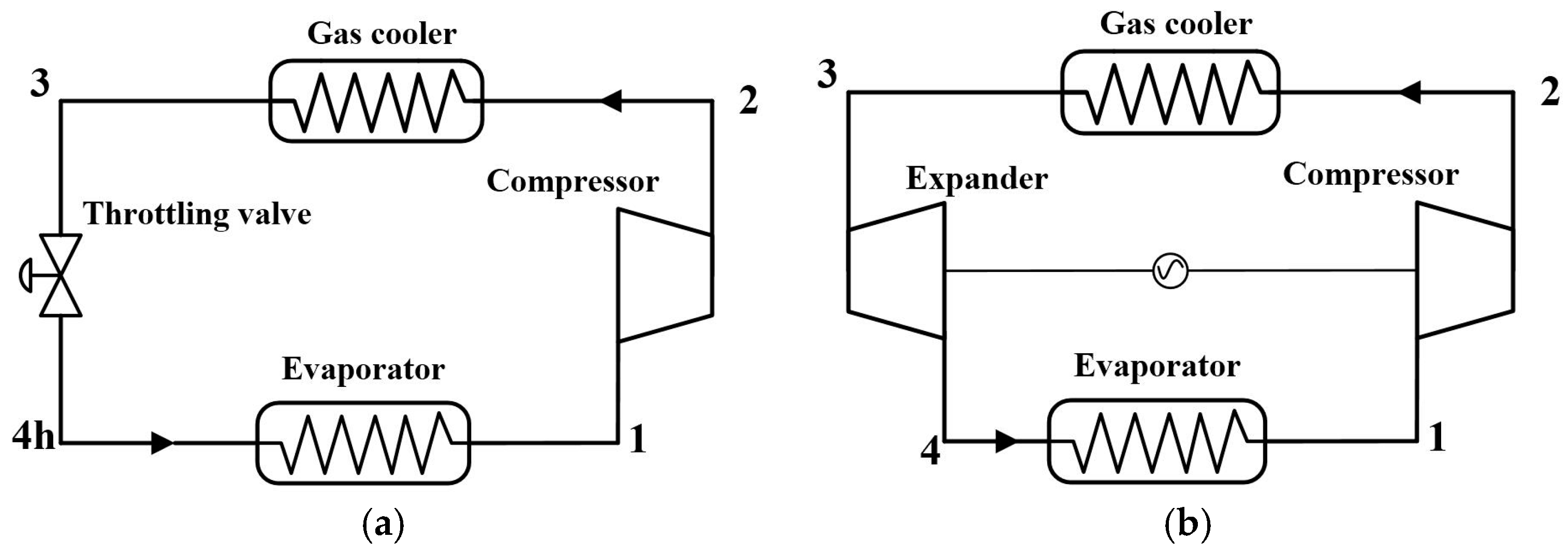
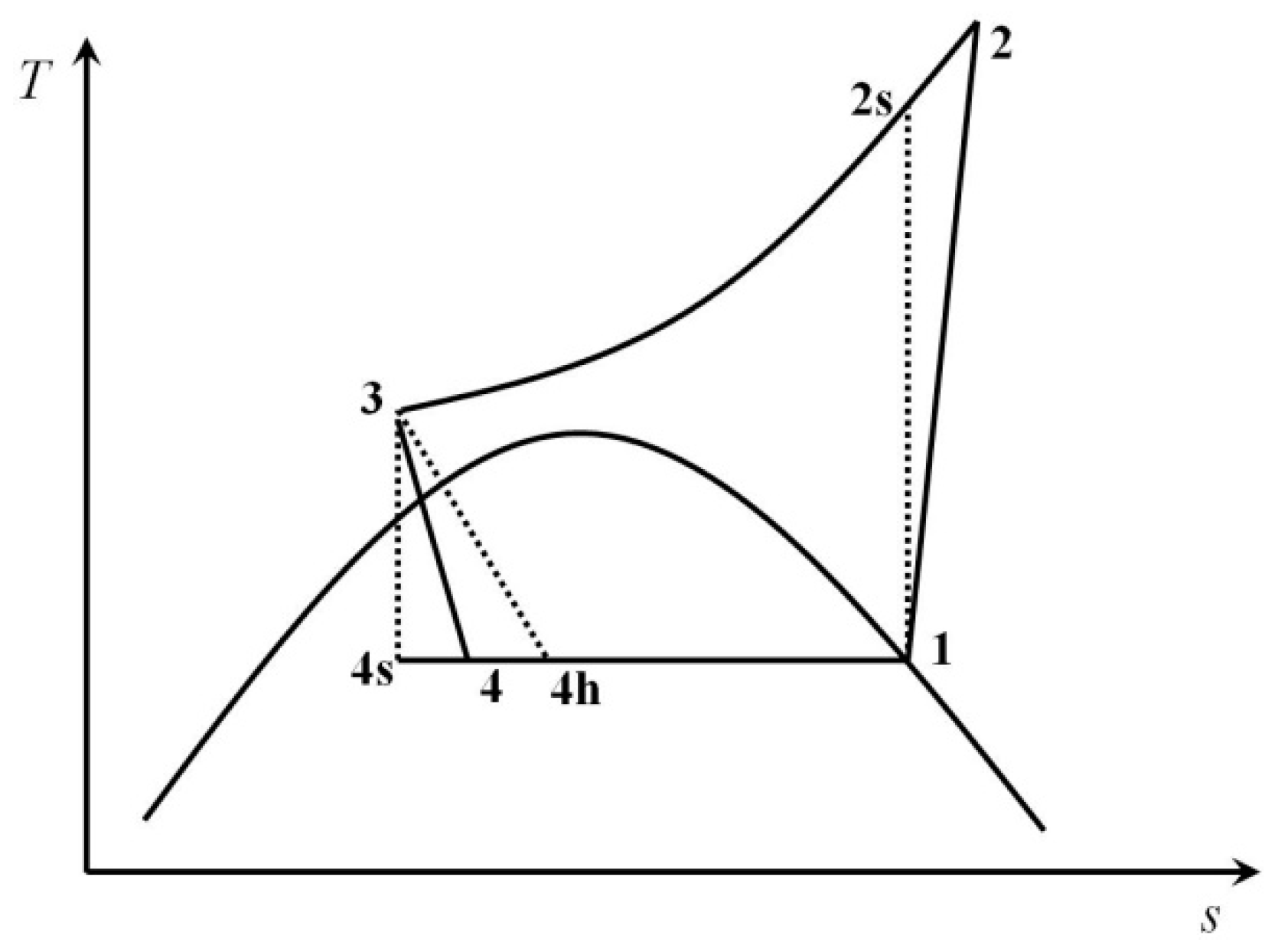
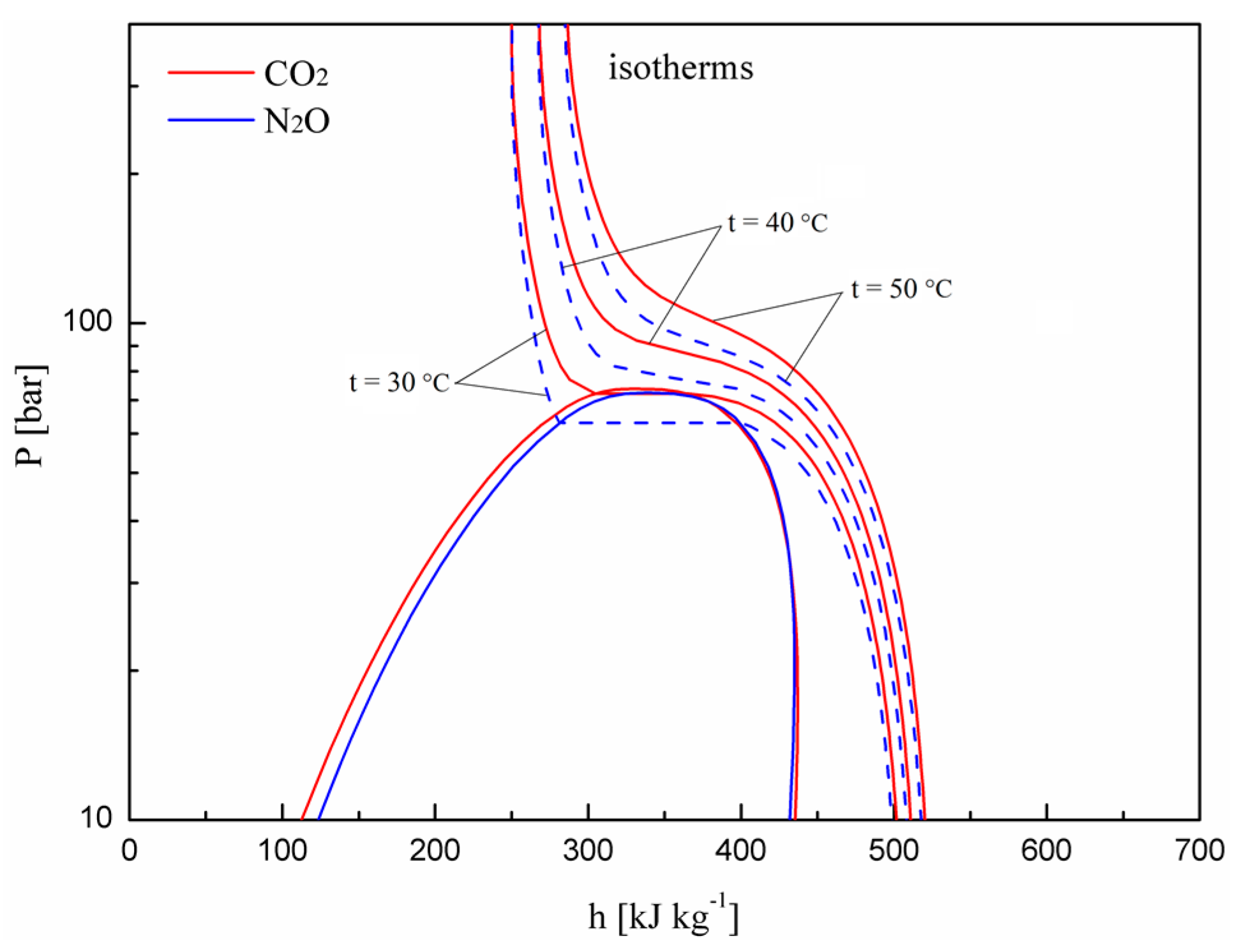

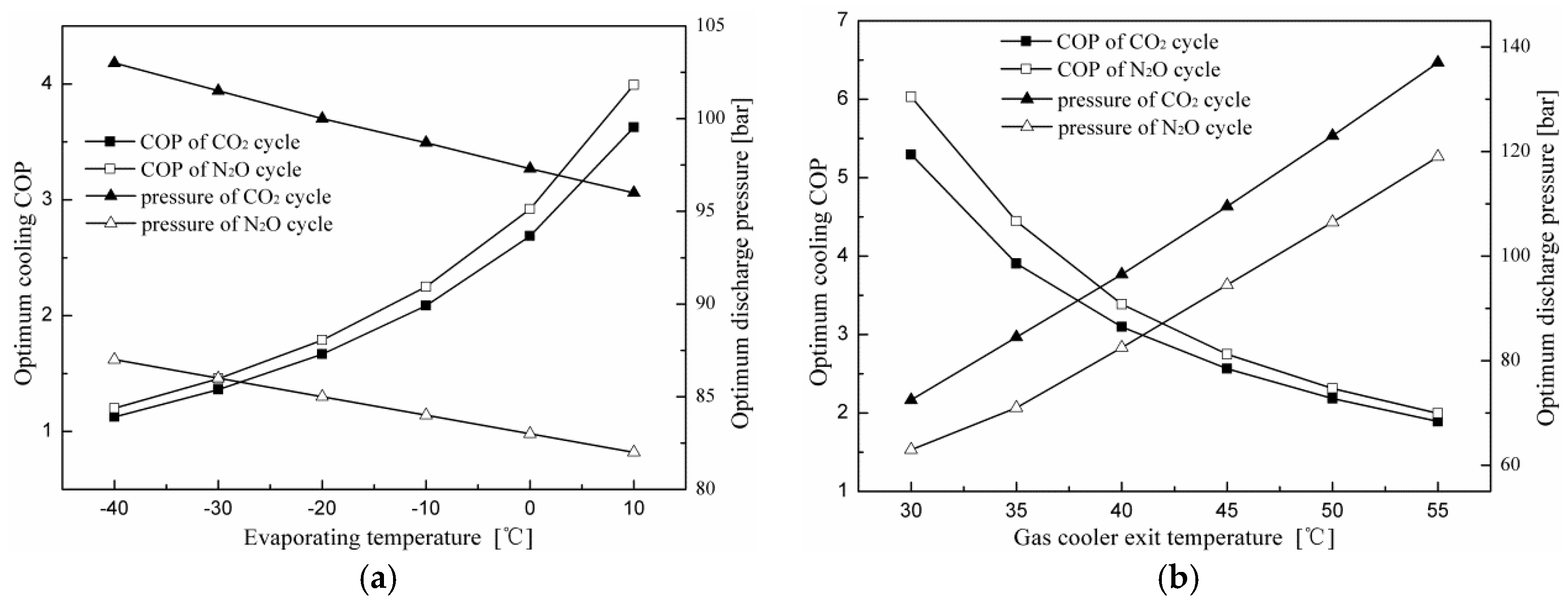
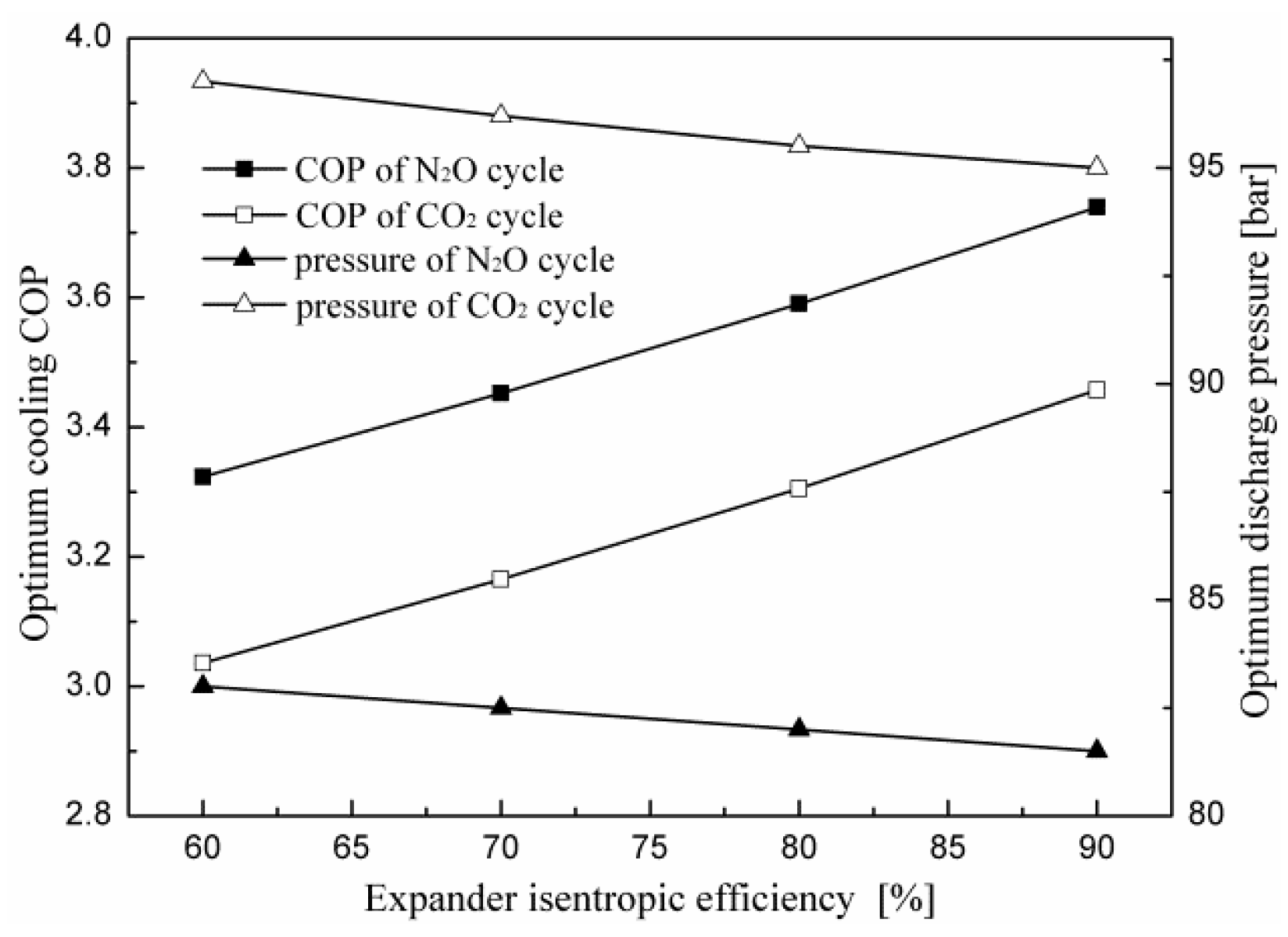
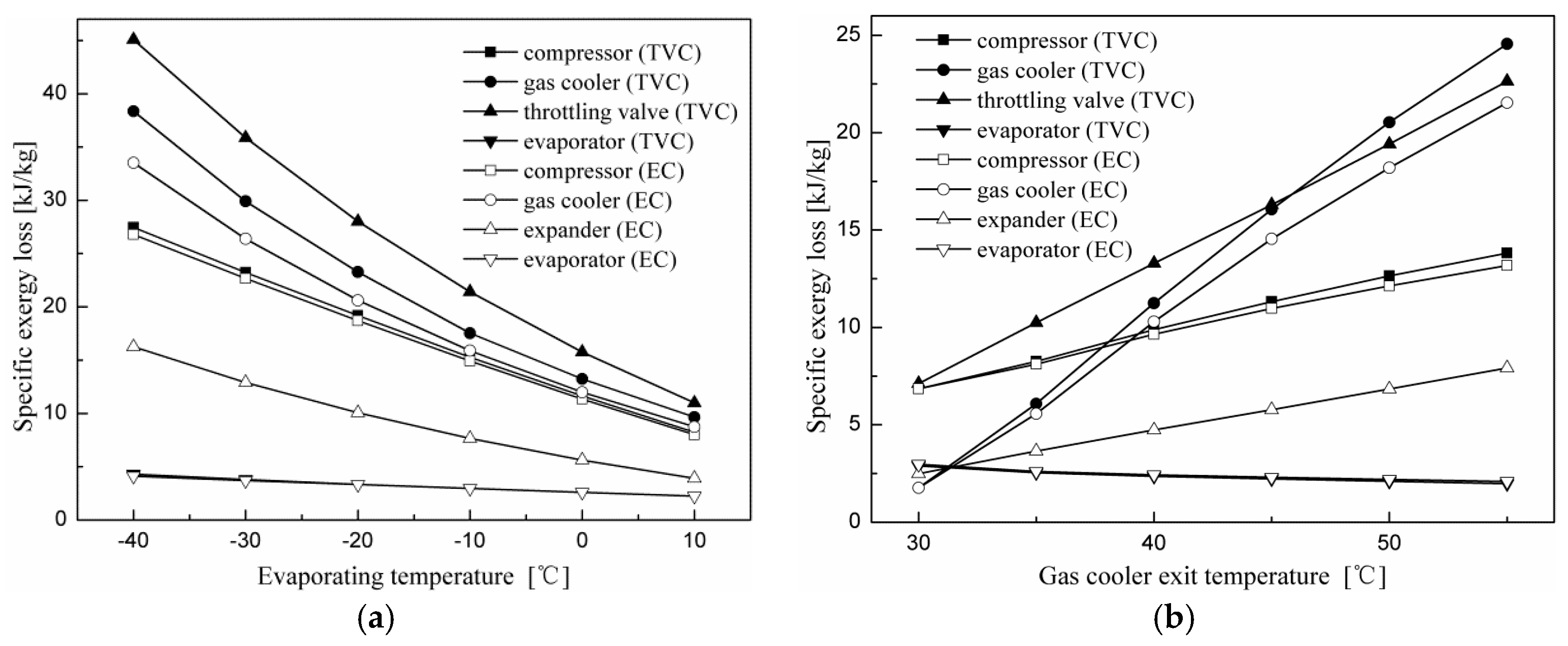
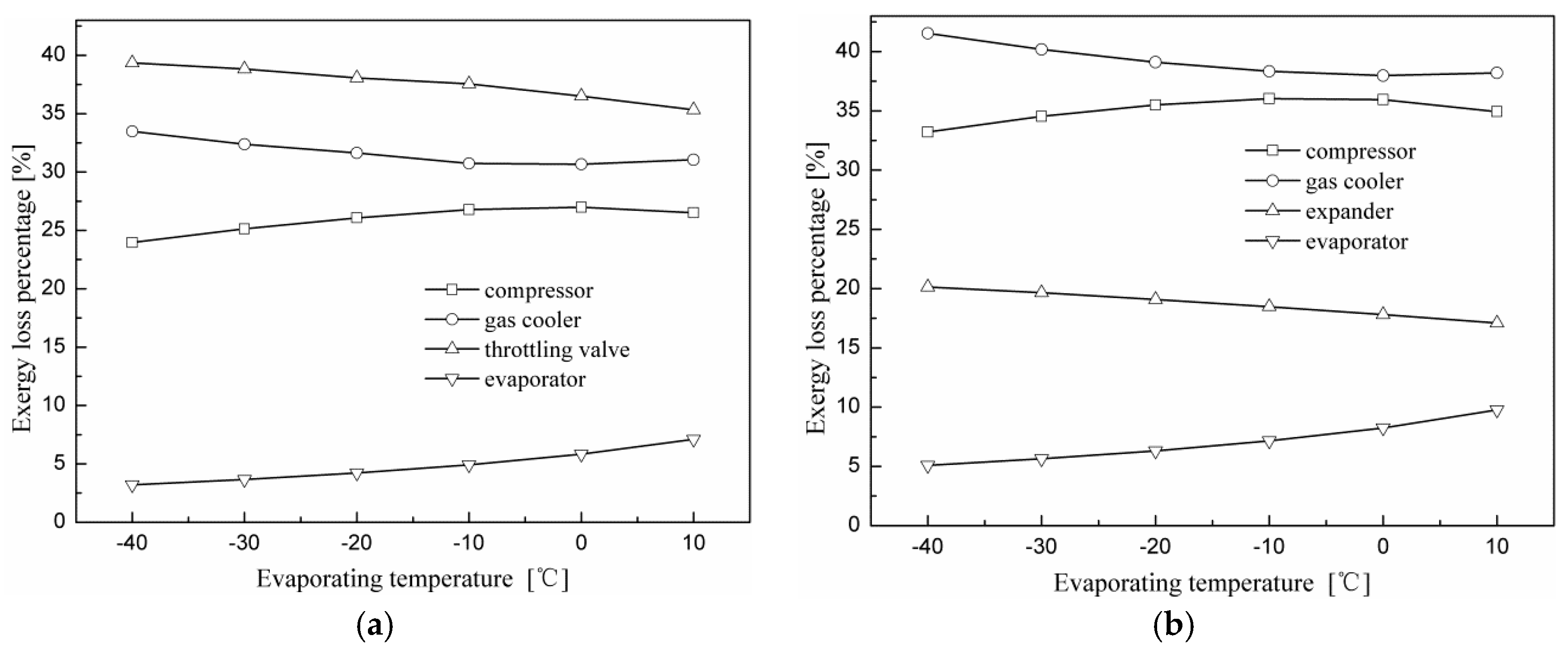
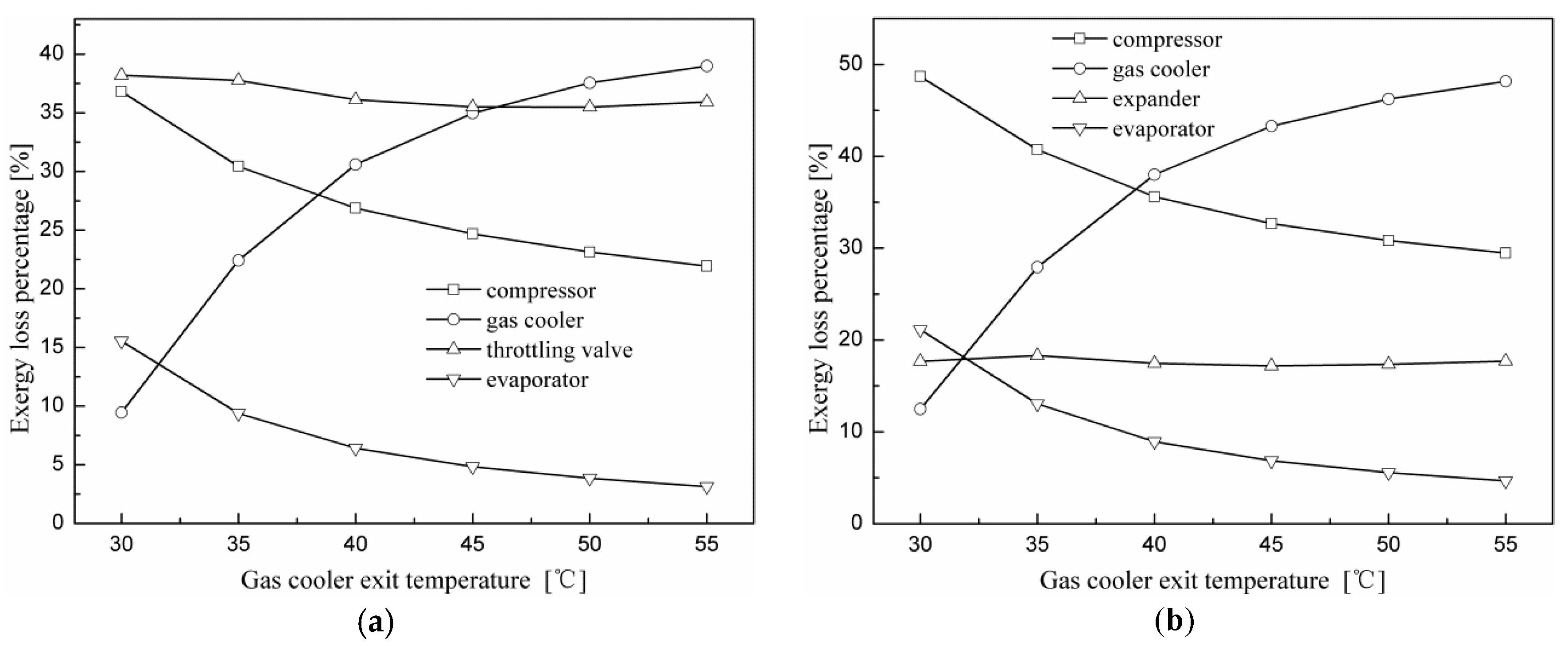
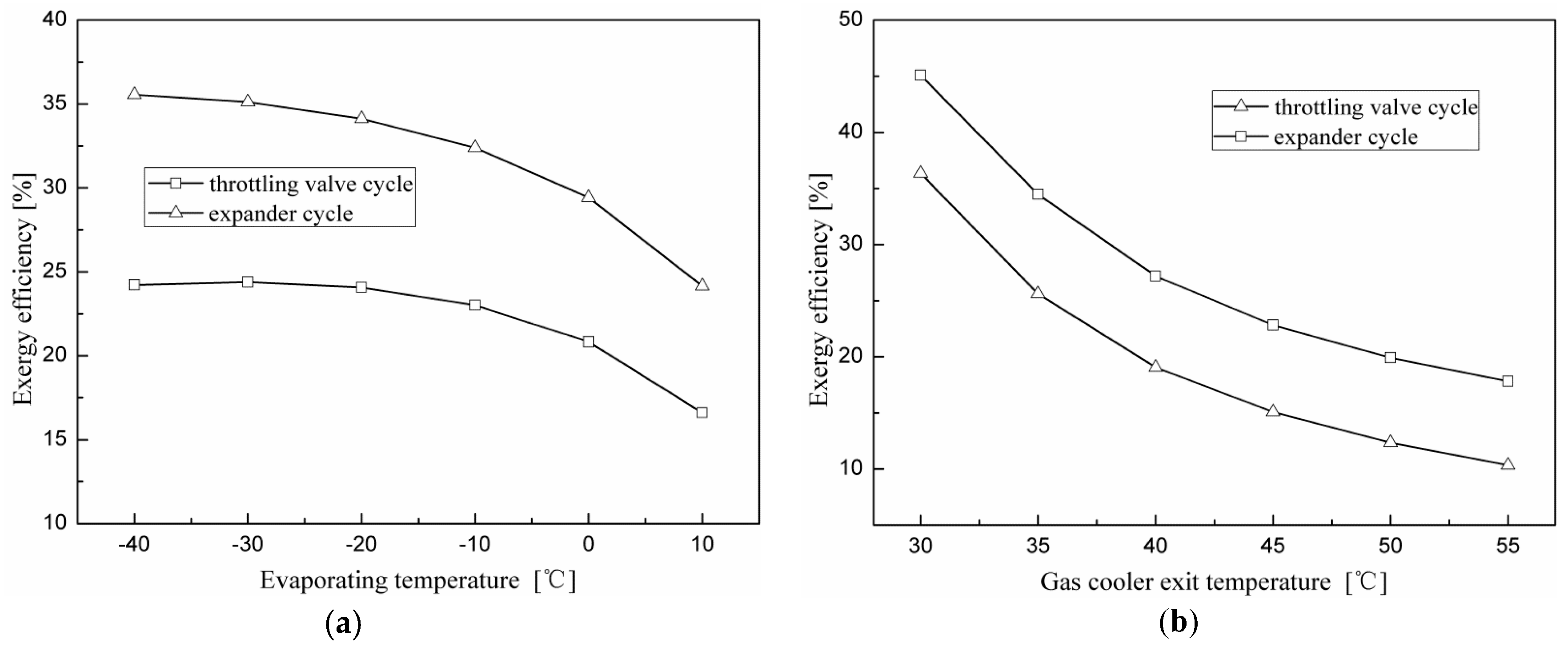
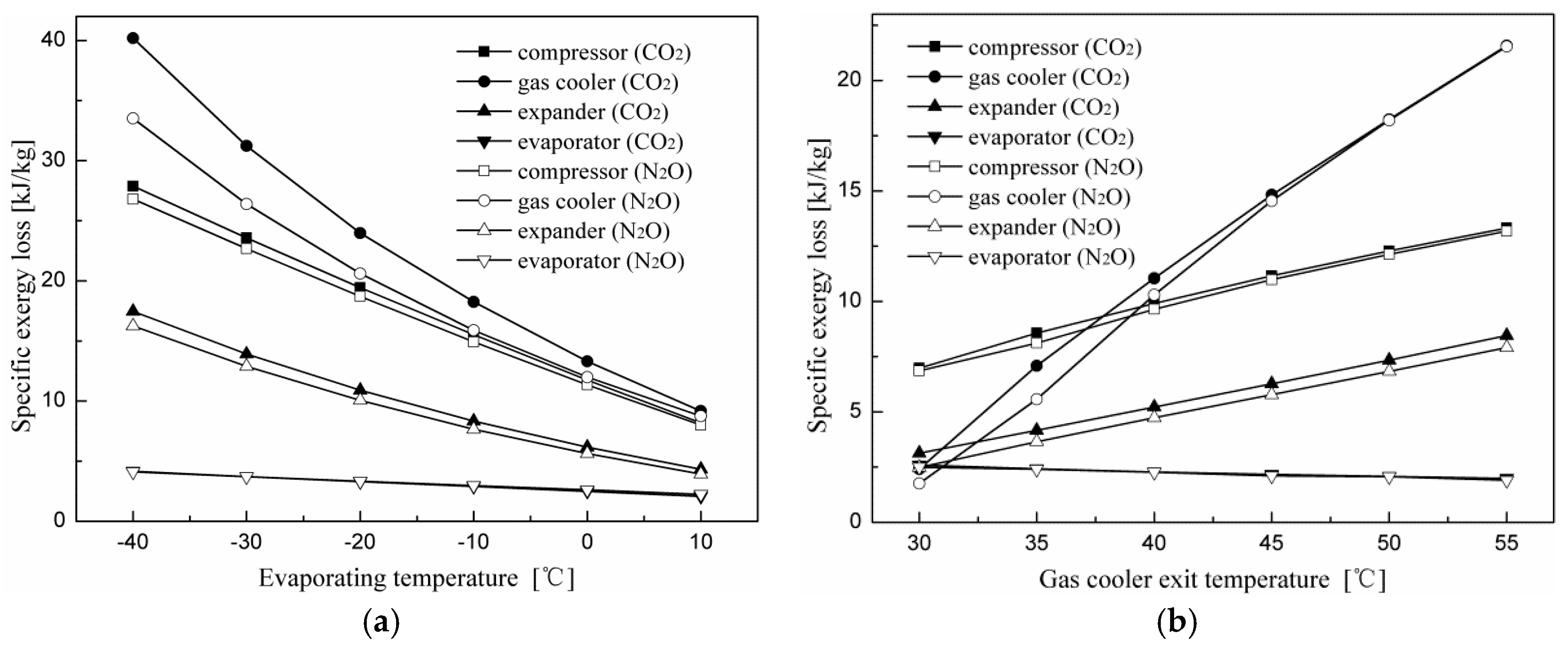


| Properties | N2O | CO2 |
|---|---|---|
| ODP | 0 | 0 |
| GWP | 240 | 1 |
| Critical temperature (°C) | 36.4 | 31.1 |
| Critical pressure (bar) | 72.5 | 73.84 |
| Toxicity (ppm) | 1000 | 5000 |
| Triple point temperature (°C) | −90.82 | −56.56 |
| Molecular weight (g/mol) | 44.013 | 44.01 |
| Subsystems | Throttling Valve Cycle | Expander Cycle |
|---|---|---|
| Compressor | wcom = h2 − h1 ηcom,is = (h2s − h1)/(h2 − h1) | wcom = h2 − h1 ηcom,is = (h2s − h1)/(h2 − h1) |
| Gas cooler | qgc = h3 − h2 | qgc = h3 − h2 |
| Expansion device | h3 = h4h | wexp = (h3 − h4s) ηexp,is ηexp,is = (h3 − h4)/(h3 − h4s) wexp,com = wexp ηmt |
| Evaporator | qeva = h1 − h4h | qeva = h1 − h4 |
| COP | COP = qeva/wcom | COP = qeva/wcom,elec |
| Subsystems | Throttling Valve Cycle | Expander Cycle |
|---|---|---|
| Compressor | Icom = T0 (s2−s1) | Icom = T0 (s2−s1) |
| Gas cooler | Igc = h2-h3-T0 (s2−s3) | Igc = h2-h3-T0 (s2−s3) |
| Expansion device | Itv = T0 (s4h−s3) | Iexp = T0 (s4−s3) |
| Evaporator | Ieva = T0 (s1−s4h) + (h4h − h1) T0/Tr | Ieva = T0 (s1−s4) + (h4 − h1) T0/Tr |
© 2018 by the authors. Licensee MDPI, Basel, Switzerland. This article is an open access article distributed under the terms and conditions of the Creative Commons Attribution (CC BY) license (http://creativecommons.org/licenses/by/4.0/).
Share and Cite
Zhang, Z.; Hou, Y.; Kulacki, F.A. Energetic and Exergetic Analysis of a Transcritical N2O Refrigeration Cycle with an Expander. Entropy 2018, 20, 31. https://doi.org/10.3390/e20010031
Zhang Z, Hou Y, Kulacki FA. Energetic and Exergetic Analysis of a Transcritical N2O Refrigeration Cycle with an Expander. Entropy. 2018; 20(1):31. https://doi.org/10.3390/e20010031
Chicago/Turabian StyleZhang, Ze, Yu Hou, and Francis A. Kulacki. 2018. "Energetic and Exergetic Analysis of a Transcritical N2O Refrigeration Cycle with an Expander" Entropy 20, no. 1: 31. https://doi.org/10.3390/e20010031




